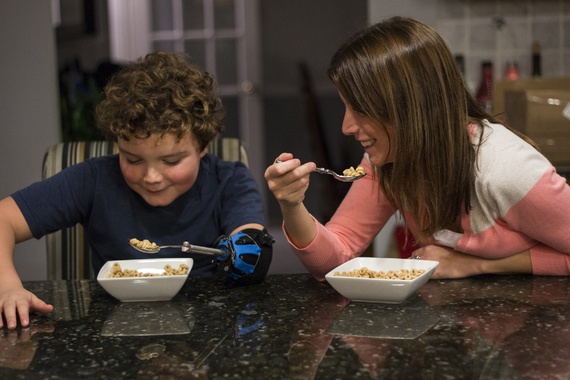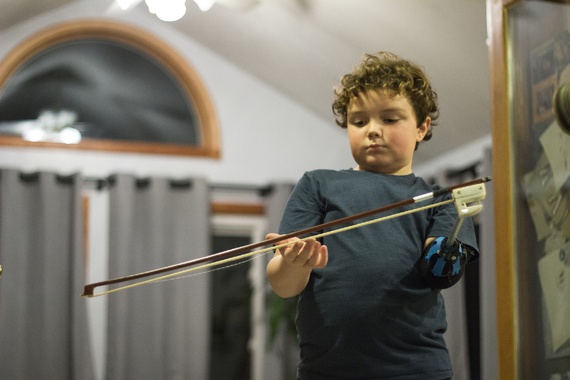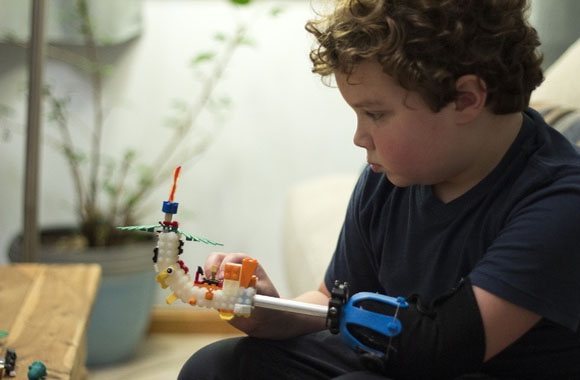Born with a left arm that ends just below his elbow, 9-year-old Aidan Robinson has had his share of prosthetic arms. As a baby, he wore a passive arm, plastic and immovable like a doll’s arm, which trained his brain to develop motor skills equally on both sides. As he grew, he graduated to more complex prostheses. Most children with an upper-limb difference—a catch-all term used to describe conditions in which limbs don’t develop to their full length—start with a body-powered prostheses, a system which use a series of cables attached to the opposite shoulder to create motion. But Robinson immediately jumped to myoelectric arms, which use electrodes to respond to subtle muscle movements. His first myoelectric arm could open at will but close automatically after a few seconds. His next arm was more complex, capable of reading two types of muscle movements instead of one, closing when he lifted his arm up and opening when he lowered it.
While the science of prosthetics has advanced dramatically, the most sophisticated prosthetic technology is still not available for children. Arms with fingers that articulate or that can do complicated motions like turning a wrist while simultaneously opening a hand often don’t even come in children’s sizes. And for some good reasons. These advanced prosthetics are expensive—basic myoelectric systems start around $15,000—whereas basic, body-powered arms for kids are far cheaper, starting around $5,500. That price difference is particularly significant when you considering that the child might outgrow the arm in a year. Kids also might not have the muscle control needed to use a myoelectric arm effectively. And children simply might not be responsible enough to make sure the arm doesn’t get wet or to charge the battery every night.
So while Robinson’s myoelectric arms were more complex than the body-powered ones that most kids with upper-limb differences use, they left a lot to be desired. The arm with an automatically closing hand, for example, is also known as a “cookie crusher” in the prosthetics community because kids who are not careful might accidentally crush something they forgot they were holding. The arm that came with a hand that opened when he lowered his arm made it difficult for him to pick up anything that dropped on the floor. When asked what he wanted out of a prosthetic, Robinson said, “When I’m doing my pushups, I want to open my hand. I don’t want to [have to] balance on it.” Two years ago, he stopped wearing his prosthetic altogether.
Even without the prosthetic, Robinson does many of the things kids his age like to do—play on the computer, compete on the swim team, study karate (he’s a green belt), and even throw perfectly round bowls on the pottery wheel. But in the coming weeks, Robinson’s prosthetic-free streak may come to an end. Last July, Robinson attended Superhero Cyborg Camp, a one-week design education workshop for kids with varying degrees of upper-limb loss. At camp, which was run by the San Francisco nonprofit KIDmob, Robinson and nine other students learned problem-solving, design and prototyping skills, and used them to design a new arm with its own superpowers.

For Robinson, being able to hold a Wii remote controller was an important power to acquire. Using old toys and parts donated from a hardware store, he fashioned together a prosthetic prototype made of a threaded metal rod onto which he could screw on different parts: his Wii remote, a fork, and a life-size version of the hands found on LEGO figurines.
One of the volunteers, a prosthetist named Erik Tompkins, helped him attach the rod to his arm by embedding it into a socket made of Aquaplast, a type of plastic that stays hard at room temperature but becomes gooey and moldable when heated to 140 degrees Fahrenheit, and securing it with masking tape. Though the prototype was less sophisticated than the prosthetics he had used, Robinson was much more excited to wear it and dream up fun, new ideas for his prosthetic.
In its short existence, KIDmob has been honing a design education curriculum that teaches “21st Century Skills”—a term that encompasses everything from problem solving to reasoning to communications. In the case of Superhero Cyborg Camp, KIDmob wanted to give its students a new framework for thinking about their limb difference. “Part of our intent was to invite them to consider the possibility that they’re not just limited to the prosthetic set on the market,” said KIDmob co-founder (and college friend of mine) Kate Ganim. “As the end user of the prosthetics, if they have an idea that’s not on the market, they could make it themselves.”
Going from a prototype to a finished product requires more time and resources than the average child can muster. At the end of the camp, most kids went home with a cool, but ultimately decorative device. Robinson, however, caught a lucky break. It happened that Coby Unger, an Artist in Residence at the 3-D design software maker Autodesk, had been invited to Skype into the camp’s final presentation from across the country in California. By the end of Robinson’s presentation, Unger was so impressed that he offered to help develop a working version of Robinson’s new arm using the resources available through his program.
“He had great ideas about what he wanted to do and wasn’t quite able to complete [them] based on the time and resources available,” Unger said. “I thought it was a unique perspective on prosthetics I hadn’t seen before. And it had great potential for changing what prosthetic means and what it could mean.”

This collaboration between a child and a professional maker has resulted in a better overall prosthetic. Unger created a version of the prototype that could be remolded and reshaped to grow with Robinson, and used materials commonly found at hardware or sporting goods stores. He made polished versions of Robinson’s Wii remote controller and fork, and also helped developed other ideas. The life-size LEGO hand attachment that Robinson presented at camp was revised into a hooked hand with the same interlocking bumps as a LEGO set so he can build out new ideas using the popular block sets. When Robinson was randomly assigned to play the violin in his school orchestra, he and Unger worked together to build a bowing attachment. Unger also threw in a Super Soaker arm for good measure.
“The conversation I want to have with this design project is, what should a prosthetic be that’s actually a positive thing that people would want who don’t need it?” Unger said. “There’s no reason it has to be a semi-functional hand or hook when you could attach something you want on there and it’s something that’s fun.”
One in 2000 children in the U.S. are born without parts of their hands or arms each year. Still more experience upper-limb loss due to accidents. For these kids, as well as adults with upper-limb differences, Robinson’s superhero prosthetic project is a sign that the prosthetic industry is changing. Currently, groups like E-nable are creating open source designs for 3-D-printable hands and arms. Robinson and Unger’s full design will be available in November on Instructables.com for anybody with a 3-D printer to use.
Of course, few children with upper-limb loss have access to 3-D printer, let alone a world-class product designer with vast fabrication resources at his fingertips. But the more prosthetics designers can hear from kids about what they want, and help them design limbs they aren’t embarrassed of, the better they’ll be. And if they can involve superheroes somehow, all the better.


